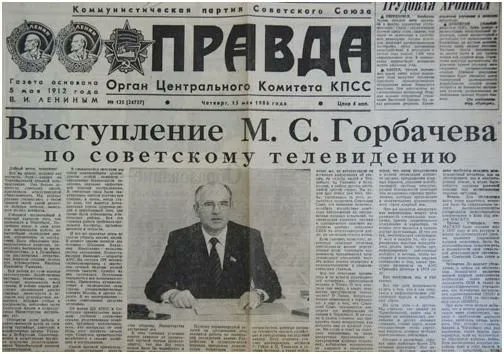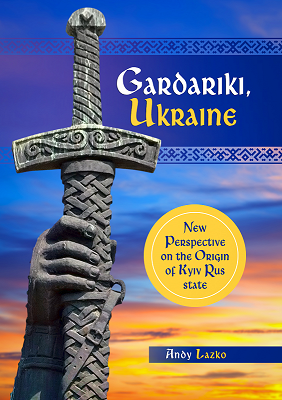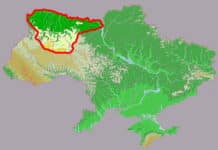“At 1:23 a.m. on Saturday, April 26, 1986, a bit more than 90 miles from Kyiv (and near the city’s main water reservoir), an explosion blew the roof off Chornobyl’s fourth reactor building and, among other tragic consequences, huge quantities of radioactive particles began spewing into the air. Other than an immediate scramble by Chornobyl workers to try to put the fire out, there was no official reaction to this catastrophe — no announcement, no warnings, nothing indicating concern for the population of Ukraine, people in other areas of the Soviet Union, or anyone in the world beyond the Iron Curtain… At 9:00 a.m., Monday, April 28 — more than 55 and a half hours after the explosion — an alarm went off at the Forsmark Nuclear Power Station in Sweden; high amounts of radioactivity were being detected. Workers were evacuated. High radiation levels were simultaneously detected in Denmark, Finland, and Norway. Scandinavian experts soon determined that the incoming nuclear cloud had originated in the Soviet Union, specifically Soviet Ukraine. But when Sweden asked Moscow for an explanation, Soviet authorities denied anything had happened, even though by then radiation had been spewing for days from the explosion and resulting fire. Not until April 28 at 9 p.m. (65 hours after the explosion), and only after the Scandinavian countries had announced the source of immense radiation, did the Kremlin come forward, and then only slightly. A newscaster on the Moscow evening news program Vremya reported, “An accident occurred at the Chornobyl Atomic Power Plant and one of the reactors was damaged. Measures have been undertaken to eliminate the consequences of the accident.”
Over the next few days, only snippets of information got out of Ukraine from the few people who were aware of what had happened and some of the consequences. Into the void of real information flowed terrifying misinformation, resulting in reports of staggering death tolls, hospitals overwhelmed by dead and suffering, and mass graves. As a result of Moscow’s irresponsible silence, people in Ukraine who wanted to know anything had to find a way to receive Voice of America, Radio Liberty, and/or Radio Free Europe broadcasts despite the extensive Soviet radio-wave-jamming facilities established in Western Ukraine. At 8 p.m. on April 28, VOA broadcast into Ukraine its first reports on the radiation that had been detected in Sweden and the suspicion that it came from nuclear leakage at a power plant in the Soviet Union.
Tony Barber’s first-person account published in the Financial Times a few days ago recalls his being a 26-year-old foreign correspondent working for Reuters in Moscow. He had flown to Kyiv on Friday, April 25, to see a friend. He spent the weekend touring Kyiv in the warm spring sunshine, unaware of anything going on that might threaten him. It was only when he returned to Moscow on April 28 that a colleague asked him if he had noticed “anything funny going on,” which he hadn’t. After hearing word of a nuclear disaster in Ukraine, he had an American embassy official in Moscow test him for radioactive poisoning. His body’s background levels were normal but the jeans he had worn in Kyiv sent the Geiger counter beep-beep-beeping.
By Tuesday, April 29, the Kremlin began to grasp that the world knew something significant had occurred and the Soviet government grudgingly responded in another Vremya broadcast. It acknowledged that an “accident” had killed two people, but said that “the situation had now been stabilized and was under control.” Such a statement was preposterous. By this time, nobody was buying the Soviet disinformation. On April 30, the winds that had blown the radioactive fallout over Scandinavia turned back on Belarus and Ukraine. American satellites relayed pictures of fires still burning out of control from at least one reactor and showed aircraft circling the power plant dumping chemicals to try to stop the blaze. (Within a few years, all of the young pilots who had flown those dumping missions were dead, though none of their deaths were officially attributed to Chornobyl.)
There were offers of assistance and aid from, among others, the United States and American volunteer organizations. The offers were rebuffed by Moscow, with one exception. #more#Through his longtime cozy relationship with the Kremlin, Armand Hammer was able to get American bone-marrow specialist Dr. Robert Gale invited to help the injured — in Moscow, 470 miles from Kyiv. Gale was not allowed into Ukraine.
With winds pushing the fallout back over the country and the release of radiation still continuing, the evening news on April 30 led with a story about spring flowers in Ukraine and preparations for the annual May Day celebration. Halfway through the news broadcast came a story about Chornobyl. The Soviet news agency, attempting to downplay the findings of the U.S. satellites, showed a photo of the affected reactor. It revealed little more than destruction to the reactor’s roof, with no evidence of smoke. Looking at the picture, it would be difficult for the average Soviet citizen to realize that a nuclear disaster had occurred that had released radiation over half of Europe. In an excellent 1986 article in The Ukrainian Quarterly, Yurii Bohatiuk translated the Moscow broadcast report introducing the story on Chornobyl:
Now we show you a picture taken by a man at the Chornobyl atomic power station shortly after the accident took place. As you can see for yourself there is no enormous destruction that some Western agencies are writing about, or no great fires, as there are no thousands of dead. In fact, inhabitants of the nearby settlements have been evacuated though the level of radiation had decreased during the past day and night. So it is hardly the place for the Western mass media to spread rumors.
The report also assured viewers that the air and water around Kyiv was safe and the drinking water and reservoirs were fine. And, according to Tony Barber’s report: “Dwelling in time-honoured fashion on propaganda rather than facts, Tass then issued a[n] … article alleging the US had experienced 2,300 nuclear accidents and breakdowns in 1979 alone. Hypocrisy and duplicity were as Soviet as stale bread.”
There is no way this sequence — Kremlin silence, denial, misinformation — was the result of mistakes. This strategy was all quite calculated and deliberate and, it would appear, now almost forgotten.
On the same day, April 30, CNN reported that a man in New York had been able to get through to his brother in Ukraine, a hospital worker, who said that he had seen hundreds dead and that his hospital could not handle the dead and injured. Traveling French students interviewed by CBS quoted a hospital source as saying at least 500 were dead. Though factual reports by the foreign media varied greatly, the Soviet media, completely controlled by the Kremlin, continued to say everything was fine.
… Gorbachev’s government began to block Western-news-media attempts to report on Chornobyl. American television companies were told technical problems were keeping photos from reaching communications satellites. This followed some Western news interviews with tourists in Moscow who had arrived from Kyiv and strongly disputed the Soviet casualty count and expressed great anger because Soviet authorities lacked the human decency to tell either them or the citizens of Ukraine what was happening.
The brazenness of the cover-up extended even to a Soviet embassy official, Vitalii Churkin, appearing in Washington at a briefing of a subcommittee of the House Committee on Energy and Commerce. For almost two hours Churkin talked in circles. Pressed by direct questions to explain why the Kremlin had not warned other countries, he replied, “It is my opinion that there was no real harm to other countries.” This, the Soviet view, was being expressed on Capitol Hill on Thursday, May 1, as the parades were under way and a spy satellite was transmitting pictures of the fires still burning, while Ukrainians in Kyiv and around Chornobyl were still in the dark as to the poisons they were breathing. Even as the Voice of America and Radio Liberty increased the number of their broadcasts in order to warn anyone who could pick up a signal, the Soviets had not yet issued the most basic of emergency announcements, no food or water or safety precautions.
It was not until May 6 that announcements ran on Kyiv local radio and television warning the population to close their windows, to wash and peel vegetables, and to keep children indoors (directives similar to ones foreign governments hundreds of miles away had given their citizens over a week earlier). These tragically delayed announcements immediately led to thousands flooding train stations and all potential routes out of Kyiv; the Soviet government quickly established travel controls. Only a certain number from each family could travel — families had to prioritize who among them could try to escape and seek help. Armed police blocked the main roads leading out of Kyiv. The authorities’ tight control of travel out of the area continued for weeks.
On May 7, the New York Times reported that large numbers of uniformed police and plainclothes KGB agents were at Moscow’s Kievsky train station when trains arrived from Kyiv, mostly with children and elderly women. The officials were doing everything they could to prevent Western journalists from interviewing the arrivals. They ordered reporters to leave the station and turned away a television crew while whisking away the Ukrainian arrivals. But it was obvious that the West was aware of the panic that had set in, so the Kremlin began to release more doctored information. The bland reports that everything was under control morphed into graphic descriptions of the Motherland’s Finest fighting 100-foot high flames after the initial explosion. Again, Yurii Bohatiuk’s article translates the Soviet press describing the firemen’s efforts: “Their boots stuck in bitumen that melted because of high temperature, soot and smoke made it difficult to breathe, but the brave bold men kept on fighting the blaze courageously.” Still there was no mention of casualties or the risk to people still being exposed to large doses of radiation.
As the days wore on and pressure grew for the Kremlin to explain what had happened and was happening, the Soviets stumbled over their lies and their profound incompetence amid the growing exposure of their near total disregard for the people. The situation is under control, everything is fine. The people in close proximity to the plant were evacuated immediately. The evacuation of Prypiat was not completed until May 6. A total of 49,000 people were evacuated. No, 84,000 have been evacuated. Radiation readings show that the area 35 miles outside Chornobyl and in Kyiv is safe. It looks like much of the area around Chornobyl will be unlivable for at least 100 years. If it weren’t so deadly serious, this zig-zagging might have been comical.
On May 9, an early summer holiday was announced for Kyiv’s quarter of a million school children, although at the same time authorities were saying radiation levels were normal. Enjoy the holidays — inside.
Mikhail Gorbachev, whom the Western media helped so much to acquire a “progressive” image, took 18 days to make up his mind what to say to the anxious populations of Eastern Europe and the citizens of the countries he was supposedly leading. On May 16, after having entertained the president of Angola and after visiting various factories in Russia and taking part in those glorious May Day celebration as if nothing had happened, the chairman of the Supreme Soviet was able to cross his fingers and say publicly, “As soon as we received reliable initial information, it was made available to the Soviet people and sent through diplomatic channels to the governments of foreign countries.” Progressive? More like a prototypical Stalinist; not one word of public reassurance from him for the population of the stricken area nor a single word of encouragement to the people dealing with the disaster. And, of course, not one word of truth. The strength of any system of governance can be measured at least in part by how well it reacts to the unexpected. Soviet Communism failed. Yet the Kremlin’s reaction and Gorbachev’s own behavior in the spring of 1986 seems to have been forgotten or dismissed as history marches on.” (Excerpts above are taken from the National Review article)












